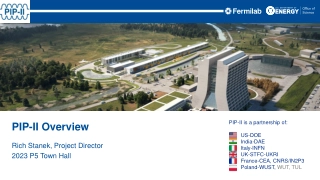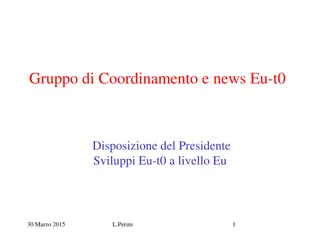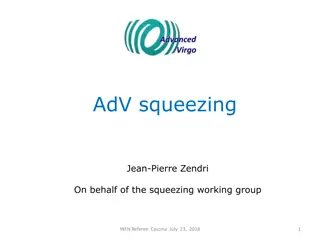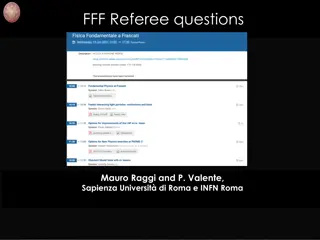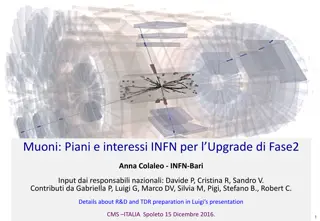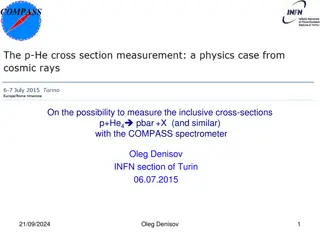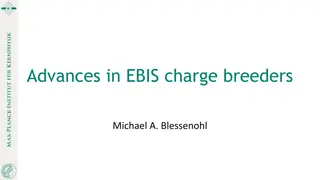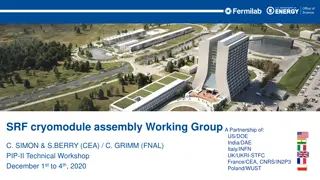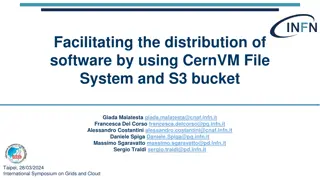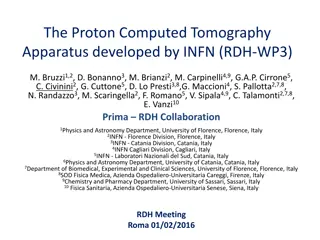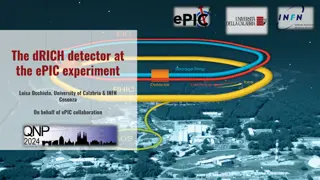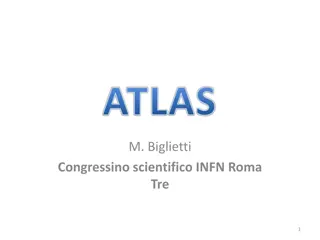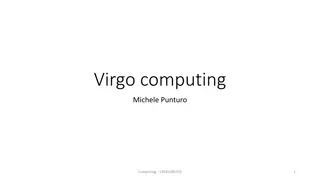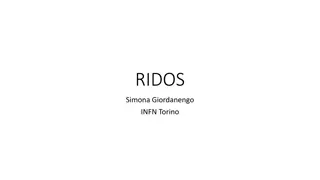Overview of PIP-II Partnership and Mission
PIP-II is a partnership involving various international institutions such as US-DOE, India-DAE, Italy-INFN, UK-STFC-UKRI, France-CEA, and more. The mission of PIP-II is to upgrade Fermilab's accelerator complex to enable the world's most intense beam of neutrinos and sustain a broad physics program
0 views • 18 slides
Advancements in Nuclear Physics Research at Laboratori Nazionali di Legnaro
Laboratori Nazionali di Legnaro (LNL) in Italy is an esteemed institute under the INFN focusing on nuclear physics and nuclear astrophysics. With cutting-edge accelerators and experimental apparatuses, LNL conducts research on nuclear spectroscopy, reaction dynamics, production of exotic beams, and
0 views • 25 slides
Updates on EU-T0 Coordination and News Development - March 2015
The content discusses the progress and initiatives related to EU-T0 coordination and news development, along with the formalization of strategies undertaken in early 2015 for resuming meetings under the EU-T0 framework. It also covers the topics, discussions, and synergies related to EU projects, in
0 views • 15 slides
Advanced Virgo Squeezing Working Group Overview
The Advanced Virgo (AdV) project involves various activities related to squeezing technology, optical layouts, Faraday isolators, and electronics. The project includes components like the squeezer, clean room, detectors, telescopes, and alignment systems. The installation, commissioning, and status
0 views • 34 slides
Exploring Dark Matter and Fundamental Particles Research Updates
This collection of images and information delves into the research activities led by Mauro Raggi and P. Valente from Sapienza Università di Roma and INFN Roma. It discusses the challenges and possibilities in parameter space coverage, potential tests required for efficient extraction from electron
0 views • 11 slides
Muon Phase2 Upgrade: INFN Collaboration for Detector Enhancement
The Muon Phase 2 upgrade project aims to improve the performance of muon detectors for the HL-LHC conditions. Collaborating with INFN, the project focuses on maintaining excellent triggering and measurement capabilities under harsher conditions. Key aspects include existing detector consolidation, n
0 views • 17 slides
Measurement of Inclusive Cross-Sections with COMPASS Spectrometer by Oleg Denisov
Oleg Denisov from INFN Turin explores the possibility of measuring inclusive cross-sections for processes like p+He4, pbar+X, and more using the COMPASS Spectrometer. Plans involve utilizing proton beams, a universal spectrometer for identifying antiprotons, and achieving precise measurements in a w
0 views • 21 slides
Advancements in Rare Isotope Research at EURISOL Town Meeting
Cutting-edge research and facility developments in the field of rare isotopes were showcased at the EURISOL Town Meeting in INFN - Pisa. Topics included advances in EBIS charge breeders, the ARIEL Extension facility, and the CANREB laboratory with Electron Beam Ion Source technology. Various aspects
0 views • 39 slides
SRF Cryomodule Assembly Working Group Technical Workshop
Partnership between US/DOE, India/DAE, Italy/INFN, UK/UKRI-STFC, France/CEA, CNRS/IN2P3, Poland/WUST for the SRF cryomodule assembly working group. The workshop agenda includes topics like vacuum sealing, staffing, maintenance, production, alignment, instrumentation, and magnetic hygiene with esteem
0 views • 5 slides
Facilitating Software Distribution with CernVM File System and S3 Bucket
Facilitating the distribution of software by leveraging the CernVM File System and S3 bucket for effective sharing in a distributed environment. The INFN DataCloud project addresses the software distribution challenge through the Software Management @DataCloud solution, aiming to simplify adoption o
0 views • 22 slides
Development of Proton Computed Tomography Apparatus by INFN (RDH-WP3)
The Proton Computed Tomography Apparatus, developed by the INFN (RDH-WP3) collaboration, consists of two pCT systems for high-energy tomography. Various tests and analyses have been conducted, with plans for further testing in 2016. The system utilizes Algebraic Reconstruction Techniques and silicon
0 views • 36 slides
Performance Studies of dRICH Detector at ePIC Experiment
The Electron-Ion Collider ePIC experiment focuses on the performance studies of the dRICH detector for particle identification crucial in various physics channels. The detector features aerogel optimization, SiPM sensors, and test-beam analyses. Key capabilities include different techniques for part
0 views • 28 slides
ATLAS Physics Research Updates and Discoveries at INFN Roma Tre
Explore the latest advancements in ATLAS physics research conducted at INFN Roma Tre, including insights into Higgs boson production, multilepton final states in ttH searches, Run1 paper results, and expectations for VH(WW) in Run2. Discover the innovative techniques used for signal/background discr
0 views • 9 slides
Overview of Virgo Computing Activities
Virgo computing has been a hot topic recently, with various discussions and meetings focusing on computing issues, future developments in astroparticle computing, and funding for INFN experiments. The activities include presentations, committee meetings, talks, and challenges in computing faced by V
0 views • 34 slides
RIDOS Operations Overview at INFN Torino
Operations at INFN Torino involve various tasks such as readout, translation, communication of DDS and OTS parameters, dose computation, upgrades under development, and hardware specifications. The system aims to deliver precise and efficient treatment while continuously improving speed and accuracy
0 views • 5 slides
RF Power Amplifiers in International Partnership - Development and Contribution Overview
The collaboration between various international partners such as India/DAE, Italy/INFN, UK/STFC, France/CEA/Irfu, CNRS/IN2P3, under the leadership of James Steimel, involves the in-kind contribution of RF power amplifiers for accelerator applications. Partners like DAE/BARC and DAE/RRCAT exhibit sig
0 views • 19 slides
